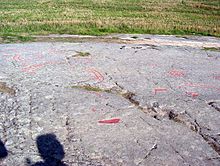Rock carvings (Allinge-Sandvig)
The rock carvings from Allinge-Sandvig on the Baltic Sea island of Bornholm are Denmark's largest accumulation of petroglyphs . They are located near the sea on a rock outcrop , near Allinge-Sandvig on a slope and date from the Nordic Bronze Age (1800–500 BC).
description
The representations that have been preserved mostly show ships. Of the 99 known scratched depictions of ships in Denmark, 67 can be found on Bornholm. Second place is taken by wheels and wheel crosses ( Hjulkors in Danish ) with four or eight spokes. Footprints occur singly and in pairs. A human figure carrying a spear was destroyed. The images are often associated with bowl-shaped indentations .
At Allinge-Sandvig, three places with rock carvings ( Danish Helleristninger ) have been preserved, a fourth place was blown up at the beginning of the 20th century. In October 2004, a new scratching area with five places was discovered near Sandvig, which is larger than the older ones and includes 16 to 18 ship drawings, among other things. Today rock carvings can be found in the following places:
- Brogård south of Allinge
- Madsebakke northwest of Allinge
- Sandvig west of Sandvig
- Storløkkebakke east of Allinge
The rock carvings by Madsebakke are best documented . There are 12 more or less strongly weathered ship pictures , as well as footprints , wheel crosses and bowls (see pictures below). The ships have different shapes and apparently originated at different times. Some of these ship carvings show similarities with the oldest in Scandinavia around 350 BC. A real ship found on the Hjortspringboot .
Madsebakke's carvings correspond to the usual image of rock carvings in Denmark. Abstract signs are found together with representational representations of people and animals. The rock carvings undoubtedly had religious significance. An explanation for the peculiar world of images can hardly be found.
- Madsebakke
Storløkkebakke south of Allinge shows four ships, a footprint and 11 bowls; There is another ship 6 m north of it. The ships are among the largest petroglyph ships. The rock carvings were found while sandblasting in 1929. The place is about 150 meters to the left of the road from Allinge towards Olsker about 500 meters after the Allinge exit sign. Unlike Madsebakke, Storløkkebakke's foot outline is provided with (four) toes, so that it is undoubtedly a (right) foot. This dispels any doubts that the outline of the foot in Madsebakke is such.
See also
- Storløkkebakke
literature
- Ingrid Falktoft Anderson: Vejviser til Danmarks oldtid. Wormianum, Højbjerg 1994, ISBN 87-89531-10-8 , p. 332.
- Peter V. Glob : Helleristninger i Danmark (= Jysk Arkæologisk Selskabs Skrifter. Vol. 7, ISSN 0107-2854 ). Jysk Arkæologisk Selskab, Højbjerg 1969.
- Flemming Kaul, Martin Stoltze, Finn Ole Nielsen, Gerhard Milstreu: Helleristninger. Billeder fra Bornholms bronzealder. Bornholms Museum et al., Rønne et al. 2005, ISBN 87-88179-68-0 .
- Karsten Kjer Michaelsen: Politics bog om Danmarks oldtid. Politics template A / S, Copenhagen 2002, ISBN 87-567-6458-8 , p. 222.
Web links
- Newspaper article (Danish)
- Images of the rock carvings by Madsebakke
- Description Engl. and pictures
- Description and pictures
Coordinates: 55 ° 16 ′ 55 ″ N , 14 ° 47 ′ 20.1 ″ E











